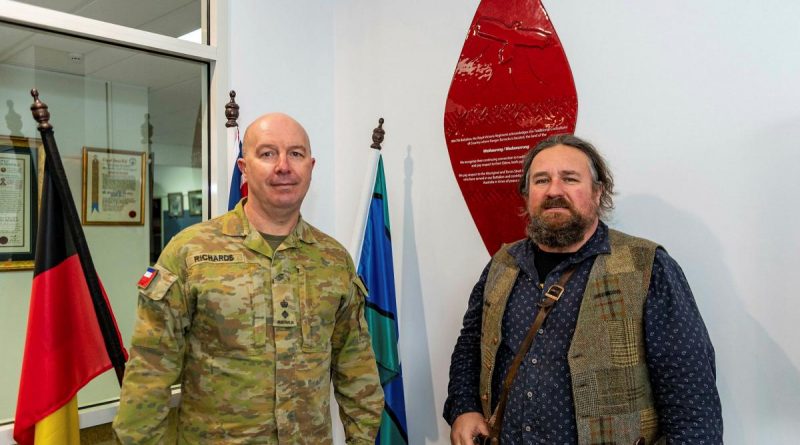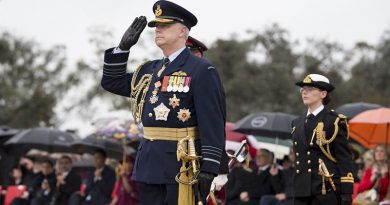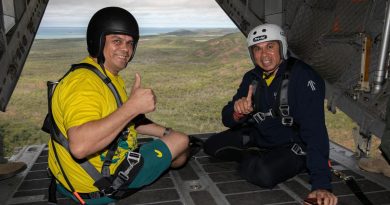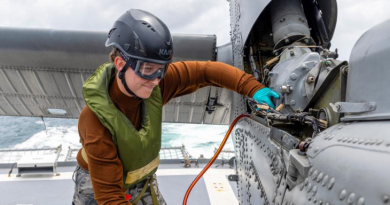Shield honours Indigenous service

A shield has been installed at Ranger Barracks near Ballarat, Victoria, to honour the Aboriginal and Torres Strait Island men and women who have served in the 8th/7th Battalion, Royal Victorian Regiment.
CAPTION: Commander of the 8th/7th Battalion, Royal Victoria Regiment, Lieutenant Colonel Shaun Richards shows Wathaurong man Barry Gilson the Wathaurong Glass shield at the battalion’s headquarters. Story by Captain Kristen Daisy Cleland. Photo by Private Michael Currie.
Barry Gilson is a Wathaurong man with family ties to the Army and the Air Force who was shown the newly installed shield after he conducted a smoking ceremony at the barracks on July 6 during NAIDOC Week.
Commander 8/7RVR Lieutenant Colonel Shaun Richards and Regimental Sergeant Major Warrant Officer Class 1 Allan Ashman accompanied Mr Gilson at the shield’s unveiling.
The Wathaurong Shield recognises the continuing connection to traditional lands and waters and pays respect to the Aboriginal and Torres Strait Island men and women who have served in 8/7RVR and contributed to the defence of Australia in times of peace and war.
The shield was created through an Aboriginal community control organisation, Wathaurong Glass & Arts, which is a not-for-profit business based in regional Victoria that only employs Aboriginal staff.

CAPTION: Barry Gilson conducts a smoking ceremony at the headquarters of 8th/7th Battalion, Royal Victoria Regiment, Ranger Barracks, Ballarat, as part of NAIDOC Week. Photo by Private Michael Currie.
Meanwhile, members of the 8/7RVR and other personnel of the 4th Brigade took part in the smoking ceremony.
Mr Gilson shared stories of his ancestors and of the land on which Ranger Barracks is situated.
This year’s NAIDOC Week theme was ‘Heal Country!’ which urges people to implement stronger measures to recognise, protect, and maintain all aspects of Aboriginal and Torres Strait Islander culture and heritage.
Lieutenant Colonel Richards said it was not only important to engage with local Indigenous people, but also to support the communities.
“It was an honour to participate in the smoking ceremony in celebration of NAIDOC Week. During the ceremony, we listened to the stories that Barry Gilson shared of his ancestors and their experiences, including that of his grandfather who fought during World War II,” Lieutenant Colonel Richards said.
“It is a reminder that for more than a century, Indigenous personnel have provided, and continue to provide, a vital contribution to Defence capability.”
Formation Indigenous Liaison Officer at the 4th Brigade, Captain Robert Powell, said connecting with the local Indigenous communities was a priority all year round.
“NAIDOC Week gives us a chance to engage with the First Nations people of our area, allow us to show our commitment towards reconciliation, and the theme “Heal Country” resonates greatly,” Captain Powell said.
“The smoking ceremony is an ancient custom that uses the burning and/or smouldering of native plants to cleanse the space in which the ceremony takes place. This activity allowed members of the battalion to share culture, embrace reconciliation and enhance cultural understanding.”
Reconciliation is a fundamental aspect of Defence’s cultural reform agenda, specifically building capability through inclusion.
NAIDOC Week is acknowledged in Defence as part of its commitment to the National Agreement on Closing the Gap and in line with the Defence Reconciliation Action Plan 2019-2022.
.
.

.
.





